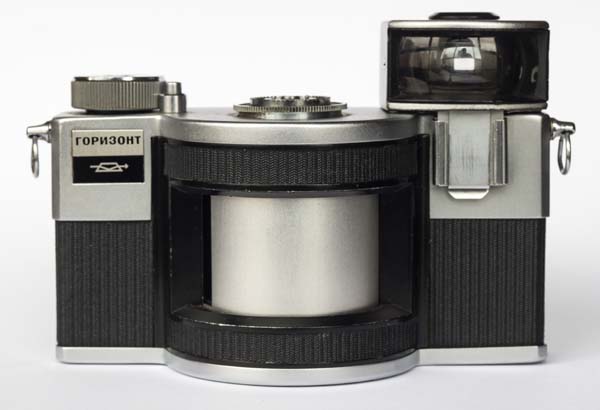
This is a camera for panoramic pictures. Горизонт means horizon and KMZ: Krasnogorski Mekhanicheskii Zavod. There is no official definition of a panoramic photo, but if we try to give numbers to the common sense, it would be an image in which width is at least twice the height and the horizontal viewing angle would be something close to 120 ° or even more .
Translating to the impression that such a frame gives the viewer, it would be a photo that sweeps horizontally a good portion of the scene that the photographer had before him when he took the photo. At a 120 degree angle, we can imagine that someone at the picture site would have to turn his head and not just move his pupils to enjoy the scene with comfort. It is a camera with a natural vocation for landscapes, but not restricted to them only.
Among the most common, we can highlight three types of techniques to obtain panoramic views: juxtaposition or photomontage, wide angle and swinging or rotating lens.
Panoramic with photomontage
That would be the simple juxtaposition of images taken with cameras say “normal”. This was probably the first technique used and consists only in the photomontage with images already printed. The drawback or difficulty is to avoid to the maximum that the joints become clearly visible. But today, with the editing capabilities of digital images, it is possible with this principle, simple and obvious, to add images of the same scene with great ease in making and quality in the final result.

View from the top of the mountain Lookout, Tennessee, print on Albúmen, February 1864, by George N. Barnard (Wikipedia)
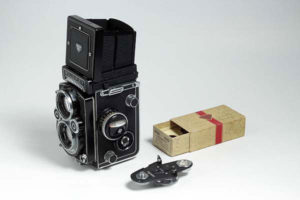 For panoramic photomontage some cameras offer tripod heads that have the convenience of rotating at predetermined angles for sequential shots up to 360 °. This is the Rolleiflex case on the side. To use this accessory it is essential that the camera is perfectly level. For this reason the panoramic head has a spirit level built-in.
For panoramic photomontage some cameras offer tripod heads that have the convenience of rotating at predetermined angles for sequential shots up to 360 °. This is the Rolleiflex case on the side. To use this accessory it is essential that the camera is perfectly level. For this reason the panoramic head has a spirit level built-in.

If the leveling is not perfect the vertical lines in the scene will not be parallel in the image. This happens with any lens, but when we turn a wide angle them the distortion can get more evident, as in the columns on the right side of the photo above. This photo, from an arena in Verona, was made with the Rolleiflex 3.5F above, using the panoramic head. The three images were mounted glued onto a card.
Panoramic with wide angle lens
The other way of obtaining panoramas would be to use a lens with a very wide viewing angle. These lenses, as it is the nature of the lenses, generate circular images but, in order to obtain the maximum in the width / height ratio, only part of the image circle is selectedt in the final photo with priority to horizontality. This would be the case, for example, of the photo below. It was made with a Schneider Super Angulon 65mm in a 9 x 12 cm film format. But although it has a ratio of 2.46 between width and height, the viewing angle is only 87 °. This is considered a super wide angle lens, but it falls short to the average of the photos considered to be truly panoramic. There are 4×5 lenses that cover up to 120º, such as the Schneider Super Angulon 47 XL f / 5.6, but this is like the maximum for a lens without very strong curvilinear distortions being introduced, like in fisheye lenses, common to 35 mm film cameras .
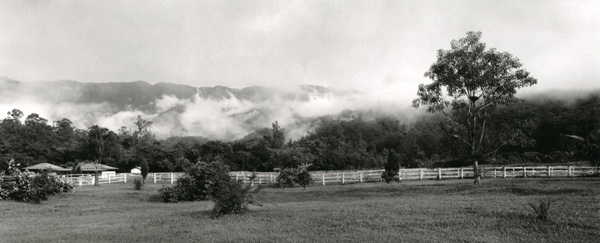
When it comes to panoramas using a single frame, with a super-wide-angle lens, the preferred cameras are those that use 120-film in formats like 6 x 17 cm. This is the case of the Linhof Technorama 617 which uses a Super-Angulon XL 5.6 / 90 with a viewing angle of 86.7 °.
Panoramic with swing lens
The third way is that using a rotating lens and resembles a scanner that records the total image by scanning. This system is almost as old as photography. Cameras of this type were already available for sale in the Lerebours et Sécretan catalog in 1846. In the illustration below we can see that the models ranged from 12 x 22 up to 16 x 52 cm in picture size. The inventor, mentioned in the description of the apparatus as M. Martens, was the German Friedrich von Marten, who worked for Lerebours.
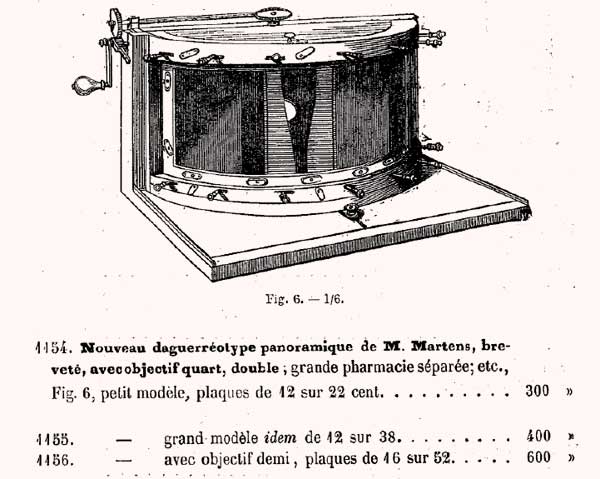
Supplement to the 1846 catalog of the firm Lerebour et Secretan – Paris
It was probably with such a camera that the below view of Paris was made. This daguerreotype is found in the Musée Carnavalet – Histoire de Paris. It was dated between 1845 and 1850 and has 10.7 x 37.9 cm, but the author was not identified.

The system requires a support that can be bent and then the daguerreotype, being a metal sheet, is something that still lent itself to such use. The biggest problem was an excessively high cost to manufacture and process such a large plate. The more affordable collodion or wet plate, process that also expanded all over the world from 1850 onwards, used glass plates and did not allow the required curvature and this type of camera was a little forgotten for some time.
The calotype, with negative support on waxed paper, could still be a solution. But apparently, perhaps because it was on the contrary, far too flexible, it was not used. The panoramic views made by this process are of the photomontage type like the one reproduced below and dated 1845. It can be noted central joint.
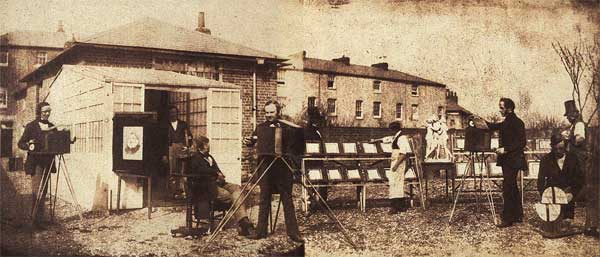
But as soon as other processes, having films as support, were invented, the idea of the swing lens was resumed. In his 1892 Ausführliches Handbuch der Photographie, which is a compilation of types and characteristics of photographic devices at that time, Joseph Maria Eder presents the model below that received the suggestive name of Cylindrographe.
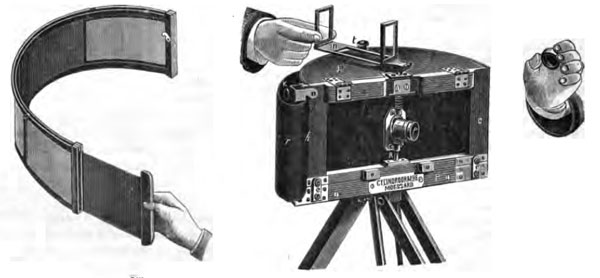
In his words: “In 1998, Colonel Moessard took up the principle given by Martens (1854) for the cylindrically curved film. The recent invention of flexible films (ie, gelatine emulsions in collodion celluloids or other flexible bases) has allowed this delicate layer to be bent. The point at which Martens failed 35 years ago is no longer a problem. ” And since then many camera using this principle have been manufactured.
The panoramic camera Horizont from KMZ
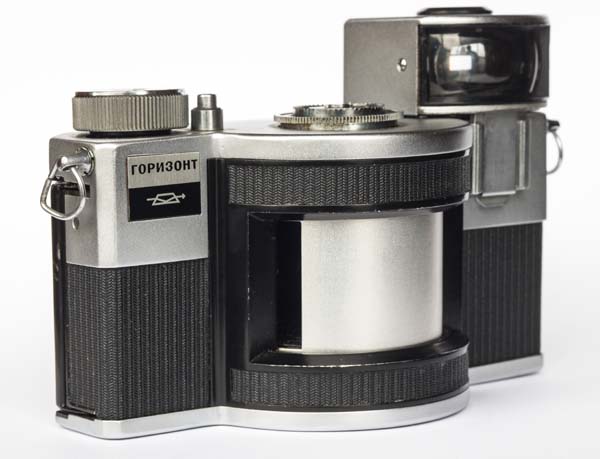
This Horizont from KMZ, manufactured between 1967 and 1973, is an instance of this lineage of panoramic cameras with swing lenses. KMZ is most famous for names like Zorki or Zenit and is active to this day. Founded in 1942 in the city of Krasnogorsk near Moscow, it initially manufactured optical goods for military use, but soon added an important line of cameras and lenses for home use. At first they were copies of Leica and Zeiss Ikon, but investments in research soon brought their own designs and solutions. Today, KMZ is again more focused on other optical instruments for industrial usage.
Horizont, derived from an old military camera, it uses a system of springs which is armed when the film is advanced, and thus produces a rotating movement at constant speed that sweeps the scene by an angle of 120 °. The frame size of Horizont is 24 x 58 mm, a ratio of ~ 2.4. It uses 35mm films. Obviously, the image could not cover the entire length of the frame, instead only a slit is covered at a time. To vary from 1/30 to 1/250 seconds, what changes is not the speed of the spin, but the width of that slit.
1) 120º corresponds to 1/3 of the circumference that has 360º in total.
2) 120º corresponds also to 58mm in the picture frame, so the circumference is 3x 58 = 174mm
3) Since the circumference is 2πr, its radius has to be is 174 / 2π = 27.69 ~ 28 mm
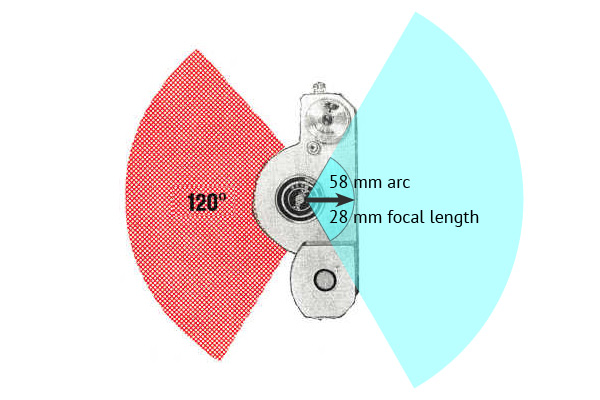
The illustration above graphically shows how the arc described by the film and the horizontal viewing angle of the camera already determine the focal length of the lens.

Speed and aperture are set at the top of the camera and the framing is done by a removable viewfinder. In the photo above the shutter is armed and the selected speed is 1/125 with aperture f / 16. Both are set with the cocked shutter. There is a vertical shoe for the viewfinder. When it’s in the camera it covers the film rewind button. It is a precise display and has a built in spirit level that is seen just below the scene being framed.
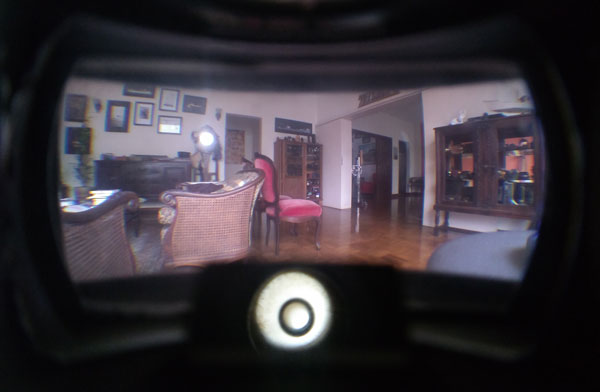
This picture, made with a cell phone close to the viewfinder window, shows the mirrowed image of the spirit level just below it. It actually sits at the top of the viewfinder.

A 28 mm lens that only needs to cover a small slit with 24 mm in height, that is the 35 mm film width, is a normal lens, not even angular it needs to be. Its vertical viewing angle is only 45º. So you can still afford to be very bright with f / 2.8. That is a very convenient as the speeds are limited with a swing lens and the lowest is only 1/30 s.
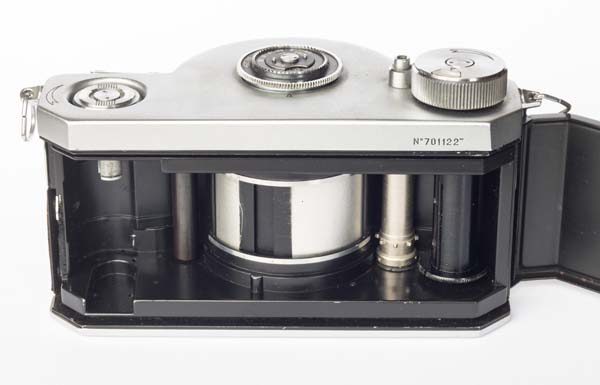
Inside its compartment the film will be curved around the cylindrical arc that gives the radius of 28 mm. It is not difficult to load the Horizont and it allows 21 photos with a film for 36 photos.
Comparison of panoramic with wide angle vs swing lens
The difference is quite significant in the appearance of the photo when using one system or another. In order to understand the reasons it is necessary to analyze what each system does in terms of image formation.
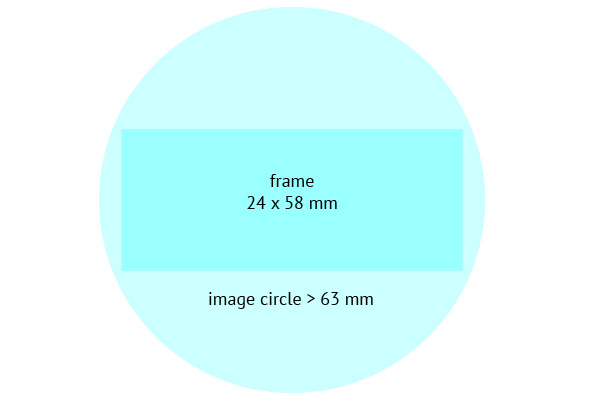
If Horizont, with the same frame of 24 x 58 mm, had a fixed lens, it would need to have a circle of image of at least 63 mm to cover the entire frame, as shown in the illustration above. To have a viewing angle of 120 ° with a circle of 63 mm, you would need a focal length of approximately 55 mm (the calculation is tg60° x 63/2). Such a lens would be very complex, expensive, probably impossible to offer f / 2.8, but with a more modest aperture it would be a possible design. One can then think that a panorama made like this would produce images like Horizont. But that is absolutelly not the case.
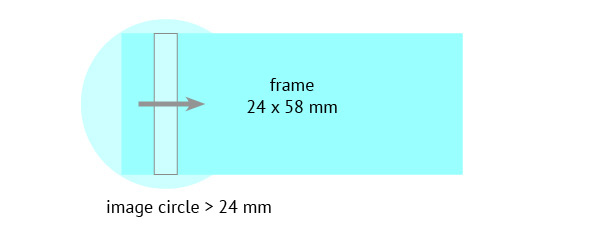
In the illustration above we have a representation of the slit that runs the frame of the picture. We have seen that the focal length is 28 mm. There is, however, one more point to consider. In lens optics the ratio of image / object size is equal to the ratio of the distance from the lens to the image and from the lens to the object. But it is easier to understand this with an image.
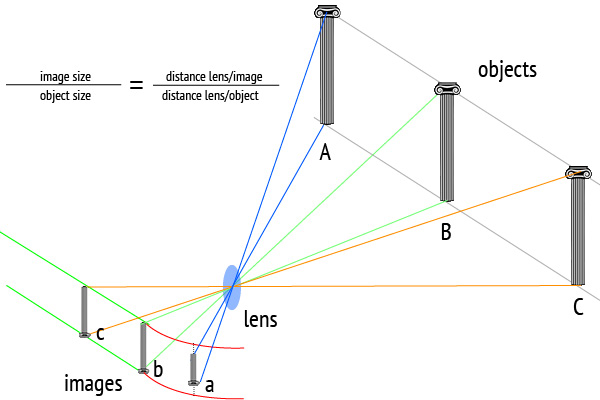
In the illustration above we are photographing three columns, A, B and C, which have the same height. For convenience, we have a hypothetical camera with two systems wide-angle and rotating lens. Thus, the plane of the images marked with green lines corresponds to the part of the wide angle. The red lines show the curvature of the film on the part of the rotating lens.
Notice then that column B, facing the camera, has its image b with a certain size. Column C is further away from the lens and therefore could have a smaller image. But see that c has the same size as b because the divergent rays of light leaving the lens for the image travel a greater distance to go from the lens to c as compared to the distance to go from the lens to b. This greater distance, from the lens to c, gives more room for the image to grow and when it reaches the film, it will present the same height as b.
Meanwhile in the part of the curved film, as the distance from the lens to the image b or up to the image a is the same, the divergent rays are interrupted when the image has not yet “grown enough” to be equal to b.
Algebraically, if we consider that in the formula the lens/image distance is fixed in the rotating lens, because it is always the radius of curvature of the film, objects of the same size will be rendered with smaller image as they move away from the lens. This happens to maintain equality: if the distance of the object / lens grows the image decreases because the other two parameters are fixed.
Panoramic pictures with the Horizont from KMZ
Horizont has this distortion very characteristic of the panoramic with rotating lens. If you photograph a line of houses across the street having the camera perpendicular to the street direction, it will almost seem like it’s not a straight street but a curve or even a corner. The effect can be useful to emphasize some central motif. I think it is the case of the photo below that has a composition all symmetrical around the store’s security guy. If the same photo would have been made with a wide-angle lens like Schneider’s Super Angulon, the front of the store would appear rectangular in the picture, as it really is.
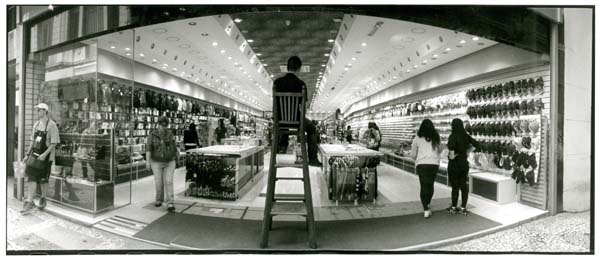
The following is an older other photo, taken on a Sunday when the express lane that borders the Seine in Paris was closed to cars. It also shows the effect in a pronounced way. The wall on the other side of the track has the same height throughout, but ends up offering the distortion exactly as in the example of the columns just above. The impression is that I was on a curve. But that was not the case. This portion of the street is straight.

Another effect that can turn out interesting with swing lens, and that appears a little discreet but still observable in the photo above, is the compression or expansion of moving objects. Note that the wheels of the bicycles are somewhat oval. This is a consequence of the fact that they moved in the opposite direction to the rotation of the lens. This print was done by the lithprint process and that is the reason of the unusual aspect of tonal scale and granulation.
Here are some more photos taken with Horizont from KMZ. I believe that this distortion can not be ignored because the impression the scene gives us may be very different from what will be recorded in the negative. Generally speaking, for panoramas of natural and mainly urban landscapes, I prefer to use a wide-angle lens. Except only in cases where the exaggerated magnification effect of nearby objects is part of the aesthetic intent of the photo. I think rotating lenses are very interesting for indoors, and photos in which the photographer places himself inside the scene. I think one example of this situation is this game of chess in São Bento street, in São Paulo.

Largo São Bento, São Paulo
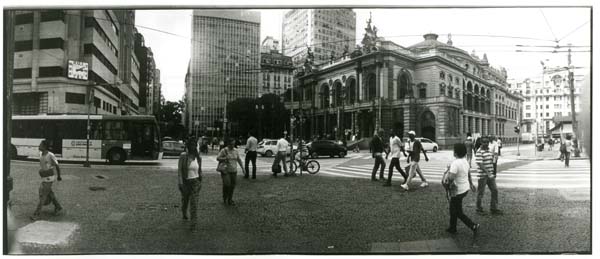
Teatro Municipal, São Paulo
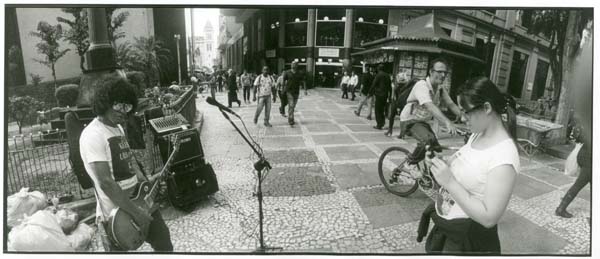
Rua São Bento, São Paulo

Alster lake in Hamburg

Hamburg

Hamburg

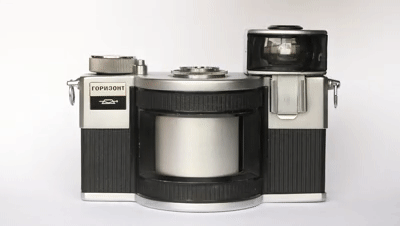
Thank you very much for the very detailed and comprehensive article!
Regards from San Francisco!
Great job.❣❣❣
Thank You, for the detailed review.
I gou an Horizint from 1971 today and will shoot with it the next days.
Regards from Germany